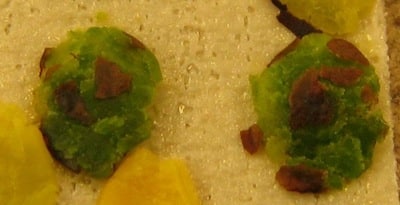Swathing too early and in hot windy conditions can contribute to high levels of green seed.
Cutting canola in hot conditions leads to rapid dry down and desiccation, which doesn’t give chlorophyll time to clear from immature seed. Waiting until less mature seed is at least firm to roll between thumb and forefinger will help minimize yield reductions from early swathing, but significant curing will still need to take place in the swath to remove green seed.
If growers feel they must swath before the ideal 60% seed colour change on the main stem, then swathing in the evening could help chlorophyll clearing enzymes to function adequately on those later seeds. Night swathing gives the plant 4-5 hours to shut down slowly, and nights are usually more humid, cooler and less windy, providing more moisture for chlorophyll clearing enzymes to function. The next day, plants in the interior and bottom of swaths will continue to be sheltered from warmest temperatures and from wind. With today’s larger swaths, the sheltering benefit of the windrow is that much greater.
Restarting the enzyme process. Enzymes to clear chlorophyll can restart when seed rehydrates to 20% moisture. (This applies only to green seed causes by premature desiccation, not to frost injury. Green locked in by seed damage from heavy frost is not likely to clear, even with wet weather.) It can be more difficult than expected to bring seed moisture levels back up to 20%. An inch of rain will not lift canola at 7-8% moisture anywhere close to 20%. Several days of heavy dew, high humidity and additional rain events may be required. These conditions can happen and at this stage of the season, growers have time to be patient with swathed canola.
Swathing early does not mean combining early. This is an important reminder. Canola swathed green can take a lot longer to cure than canola swathed at 50-60% seed colour change. Whether growers swath a green crop now or wait a week, combining could occur around the same time. And by waiting to swath, the crop has a better chance of meeting its yield and quality potential.
Early swathing and sclerotinia stem rot. A reader asked us last week whether cutting early would help stop sclerotinia stem rot from advancing and causing increased yield loss. Our answer: If growers already have sclerotinia infection, then the damage is already done to those infected plants. Swathing early will only serve to reduce the yield of those plants that are not being impacted by sclerotinia. Swathing early to prevent sclerotinia-infected plants from shattering early is not likely to provide a benefit. If the infected plants are going to shatter this early, then even swathing them now will not be a benefit since the seed will be likely really small and blow through the combine. The best move is to choose a swath timing that protects the yield of the non-infected plants.
